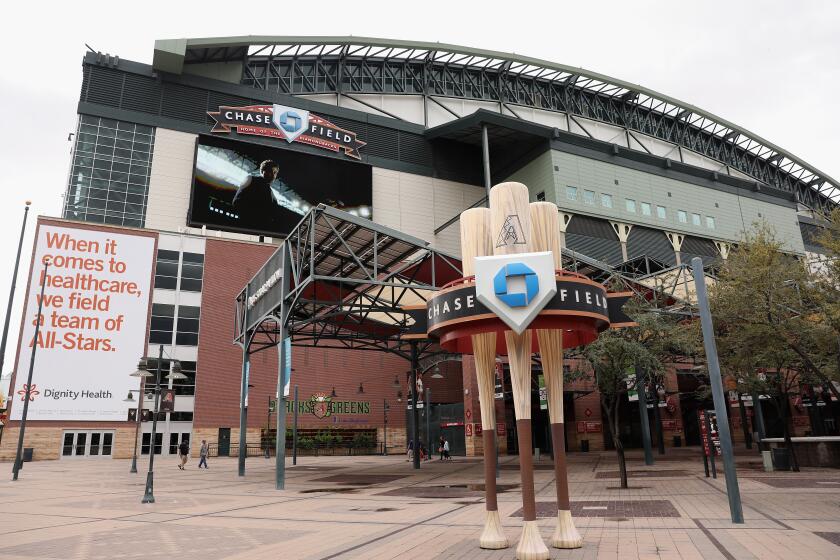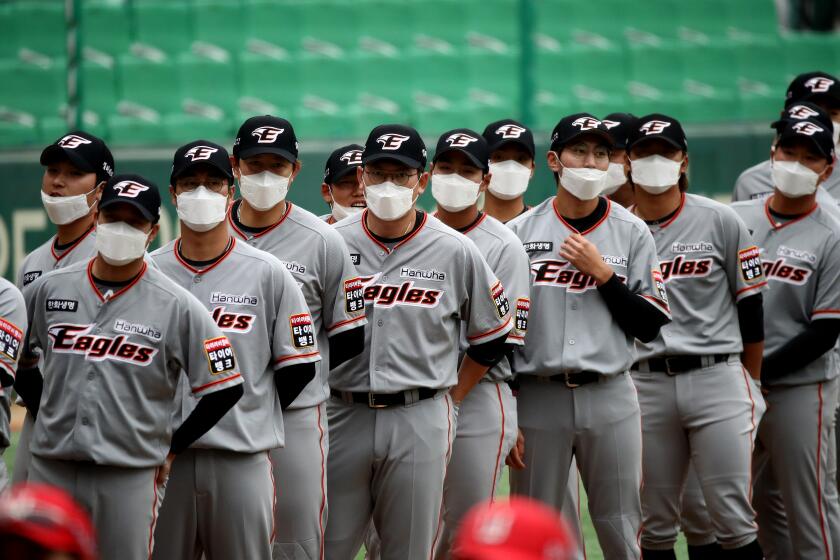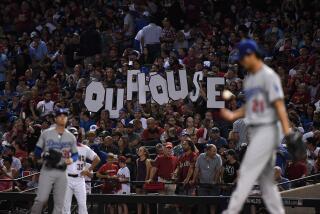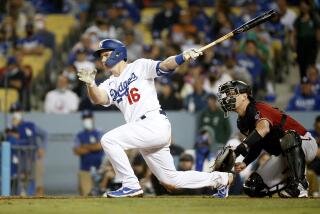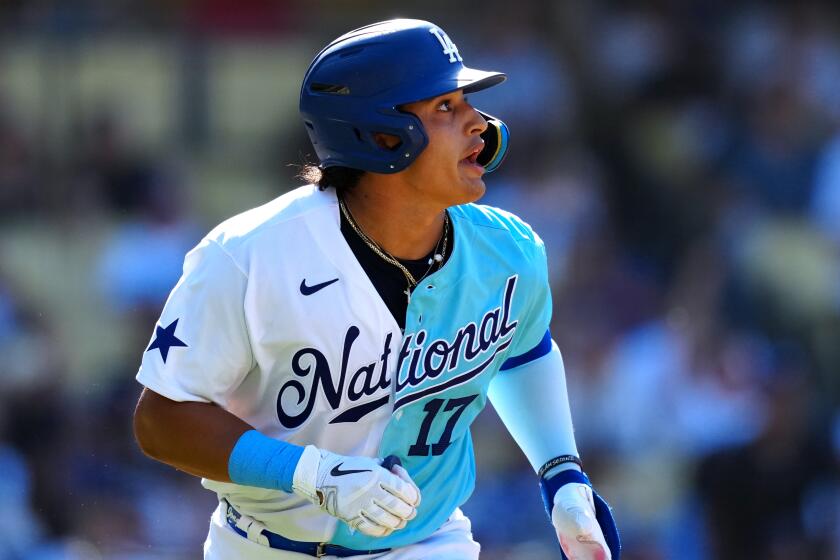Dodgers and Angels say staging games without fans would require extensive personnel
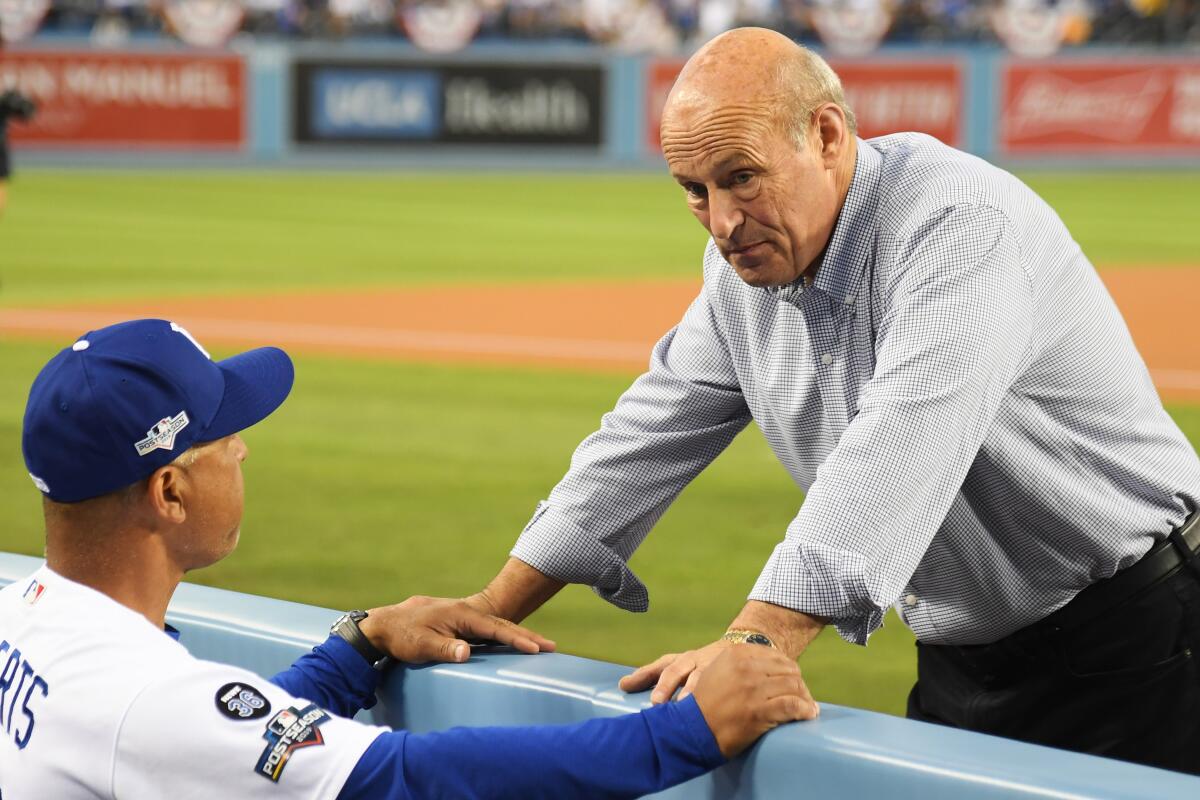
Third in a series of articles about the 2020 futures of major sports leagues.
The pre-pandemic staging of a baseball game in Dodger Stadium required “a symphony of hundreds and hundreds and hundreds of people,” in the words of Stan Kasten, the team’s president and chief executive officer.
If baseball returns this summer, that philharmonic convergence of players, coaches, executives, medical staff, media, clubhouse attendants, ushers, vendors, concessionaires, security guards, parking attendants, plumbers and electricians will be reduced to the stadium-employee equivalent of a string quartet.
Fans are expected to be excluded from the start of an abbreviated 2020 season, whether games are played in home parks with the league divided into three 10-team regional divisions (increasingly likely); games are played in Florida, Texas and Arizona (doubtful); or 30 teams begin play in the Phoenix area (highly unlikely).
That would eliminate the need for the bulk of the 1,800 or so spectator-related stadium employees Kasten and Angels team President John Carpino say are required for regular-season home games.
In an effort to reduce the exposure to and possible spread of the coronavirus, Major League Baseball is expected to limit stadium access to “essential personnel.” But who would be considered essential, and who would not?
A series examining the challenges major sports leagues, teams and athletes are facing amid the COVID-19 pandemic.
The list is likely longer than expected at first glance.
“It becomes a math model — the more people you have, the greater risk of someone either having the virus or spreading the virus,” Carpino said. “I’ve been looking at how we could do this without fans, and you keep thinking, ‘We don’t need anybody.’
“Then you’re like, what about security? Oh yeah. What about cooks in the clubhouse dining room? Oh yeah. What about a statistician? Oh yeah. What about a video guy? Oh yeah. Before you know it, you have three dozen oh yeahs. I don’t know how to attack it, almost.”
Kasten said the Dodgers have been working on models for “essential” game crews, but with no plan or date for a startup firmly in place, clarity remains elusive.
“As soon as it came up, we started looking at it, and it’s just like with everything else — we still have more questions than answers,” Kasten said. “It’s going to depend on what guidance we are given from baseball, from the city and the state, on what restrictions will be imposed for us to play a game without fans.”
MLB officials have been in constant contact with teams, the players association and medical experts as they formulate a path forward, but the league is “not ready to go in-depth on this topic at this time,” a spokesman said this week.
“I’m relying on direction from MLB, it’s something they’re talking about nonstop, seven days a week,” Angels general manager Billy Eppler said. “They’re asking clubs for feedback, they’re crowd-sourcing a lot of these questions, and they’ll come up with the infrastructure that puts the health and safety of the players and people around them at the forefront of every decision.”
MLB can choose from at least three models: allowing teams to operate in their cities; an enclosed operation in Arizona; and a three-state hub.
Kasten and Carpino said they expect MLB to issue a consistent set of guidelines to teams with limits on the number and types of uniformed and non-uniformed personnel allowed in the stadium.
Both executives estimated an “essential” group would require at least 100 people, consisting of 30-35 players, a manager, 11-12 coaches, a medical staff of 10-12 — including physicians, athletic trainers and strength-and-conditioning coaches — an equipment manager, four or five clubhouse attendants, two video-room coordinators, a traveling secretary and a handful of front-office executives.
“Will there be limitations on [clubhouse attendants]? Do both teams have the same number of trainers, doctors and X-ray technicians, or will the home team provide them?” Kasten said. “Are we supposed to operate the scoreboards? Do we need a public address announcer?
“Then there’s the whole world of the media. Are there restrictions on the numbers allowed in a stadium? Do we have pool reporting? How do we [keep reporters] separate? Are there personal interviews or is everything piped into the press box? I don’t know. Oh, we’ve got questions, man, lots of questions.”
One approach would be to have a bubble within the bubble — limiting access to the field and clubhouse to one group while allowing others access to the stadium only.
The former group would include those mentioned above, as well the four umpires, an MLB video-room monitor, two or three drug-testers on days tests are administered, a clubhouse security guard, six to 12 grounds-crew members, a handful of kitchen employees and a cleaning crew.
The latter group could include broadcasters, television and radio crew members, writers, an official scorekeeper, P.A. announcer, scoreboard and video board operators, media relations officials, baseball equipment distributors, facility maintenance crews of plumbers, electricians, HVAC technicians and mechanics and — at least, in the case of Dodger Stadium — organist Dieter Ruehle.
While much of the world is under lockdown, baseball returned to South Korea on a day when the country reported just three new cases of COVID-19.
“Even right now, with the stadium closed, we have at least six people there every day,” Carpino said. “And we still have security on site.”
If MLB imposes strict limits on stadium access, it could have TV and radio announcers broadcast games from off-site studios and writers cover games off TV with post-game interviews conducted via video chat.
One area no one wants to scrimp on is medical staffing.
“You have the skill-development side, which is your on-field coaching group, and the medical side, which is your physical therapists, athletic trainers, chiropractor, massage therapist,” Eppler said. “By and large, in all these models, we’re still talking about playing a physical game that requires a certain standard of care, and you don’t want to take that away from your athletes.”
Another issue MLB must address: If there is no minor league season, teams will have to carry taxi squads of at least 15-20 players who will need coaching, medical care, athletic training and games — with umpires — to stay sharp.
Will they work out and play in home stadiums, greatly increasing the number of people in the bubble, or at another facility?
“It’s a lot of moving parts,” Carpino said, “but I feel like MLB is definitely on it and looking at everything, and we’re looking at them to give everybody direction.”
More to Read
Go beyond the scoreboard
Get the latest on L.A.'s teams in the daily Sports Report newsletter.
You may occasionally receive promotional content from the Los Angeles Times.


